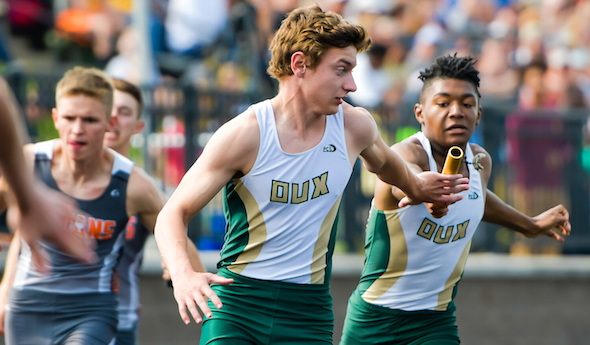
Storms Can't Squash Inspired Performances
June 1, 2019
By Matt Schoch
Special for Second Half
ZEELAND – From great-grandparents and former coaches to a mother and a son, athletes at the MHSAA Boys Track & Field Finals became champions in honor of their loved ones on Saturday.
Take senior Emari O’Brien of Harper Woods Chandler Park, who became the 100-meter Division 2 champion at 10.97 seconds at Zeeland Stadium in honor of former coach Paul Zelmanski, who died in January.
“This whole time I’ve been running, he told me I was going to win it one year,” said O’Brien, a Ferris State football signee who wrote “For Z” on his shoes. “Last year when I (took second place), he said next year when you come back, you’re going to win it for sure.
“I’ve been waiting on this for the longest time, so I have to win that for my coach.”
Athletes like O’Brien endured a three-and-a-half-hour delay and then another of 45 minutes as storms crept off Lake Michigan. Then, a final delay of more than two hours pushed the event to a 12-hour affair.
On the heels of three event wins, Zeeland West earned the team title with 53 points, topping Yale (37), Fruitport (33), Dearborn Divine Child (27) and Corunna (26).
“That means we have won every meet we have been to,” said Zeeland West’s Ethan Brooks, the only individual champion for the Dux. “It is awesome.”
Zeeland West won the 400 relay at 43.51 seconds, and the 800 relay at 1:29.29.
Brooks won the 300 hurdles at 39.38, edging Fruitport junior Ethan Flores by one hundredth of a second in his quest for a second title on the afternoon. Meanwhile, Flores said he had his family, in particular his great-grandmother, on his mind in the starting blocks for the 110 hurdles, which he won at 14.53 seconds. This, despite a slow start to his spring after basketball season leaked longer than usual.
“I didn’t have time to be at the track like I should’ve,” Flores said. “I worked by myself over Memorial Day. I wanted it, and I worked really hard for it.”
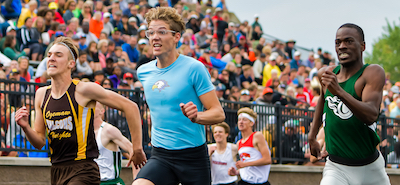 Saginaw senior Tony Martin, who is headed to Michigan State, jumped 22-11.25, winning his second straight Division 2 title. That distance came, he said, despite missing the whole board on the championship jump.
Saginaw senior Tony Martin, who is headed to Michigan State, jumped 22-11.25, winning his second straight Division 2 title. That distance came, he said, despite missing the whole board on the championship jump.
Martin credited his mother, Kishon, for pushing him through hard times this year, including a pulled hamstring that hampered his season. He also said his son, Isaiah, has been an inspiration.
Before the injury, Martin had a regular-season jump of 26-6, which is among the top all-time national jumps.
“For me to come and do what I did is pretty amazing,” Martin said. “I’m just happy that I’m back and healthy.”
Junior Dylan Targgart of Coldwater continued his decorated career with two more titles, repeating in the discus at 187-7, a personal record, and the shot put at 66-7.50, a Division 2 Finals record, breaking former Detroit Lions defensive lineman Anthony Zettel’s 2011 mark for Ogemaw Heights (61-8).
“I had thrown my PR before the delay, so I think maybe it was a good thing since other people had to sit and wait and try and PR after that,” Targgart said. “So it might’ve worked to my advantage that way.”
Targgart is probably just being modest though – he won that competition by 14 feet and then the shot by more than six.
Rounding out the field events, junior Matt Veneziano of Parma Western won the high jump at 6 feet, 6 inches, and senior Josh DeVries of Grand Rapids South Christian won the pole vault at 15 feet.
On the track, junior Luke Brenner of Ada Forest Hills Eastern won the 200 at 22.02 seconds. Yale senior Justin Kudera won the 400 at 48.74 seconds, edging last season’s champion Jacob Denison of Tecumseh by six hundredths of a second.
Otsego junior Hunter Hartman won the 800 at 1:55.56; and Corunna senior Ben Jacobs won the 1,600 meters at 4:19.79.
Jacobs also overcame a Zeeland West runner to give Corunna a win in the 3,200 relay at 7:53.20.
After the final weather delay, Dearborn Divine Child junior Anthony Hancock won the 3,200 at 9:06.65.
Yale closed the long day with the 1,600 relay win in 3:23.42 to earn second overall.
PHOTOS: (Top) Zeeland West completes a relay hand-off during its team championship run Saturday. (Middle) Runners take off to start a race at Zeeland Stadium. (Photos by Kevin Fowler. Click to see more from RunMichigan.com.)
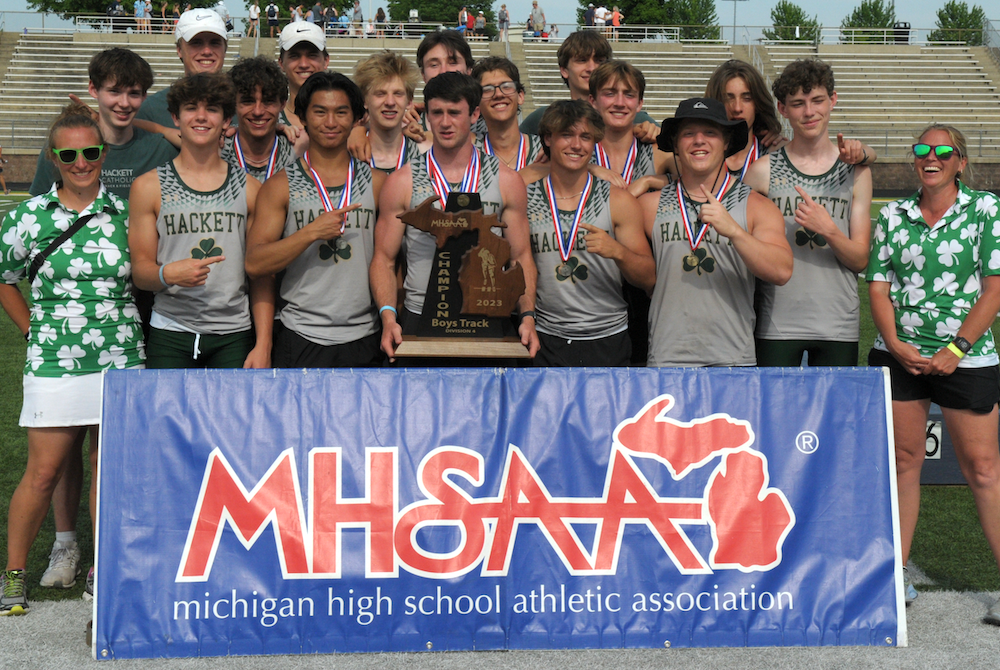
Thrower Claims Lone Individual Title to Lead Hackett to Team 3-Peat
By
Tom Lang
Special for MHSAA.com
June 3, 2023
Kalamazoo Hackett Catholic Prep just keeps winning and winning.
This time the Irish took home their fourth title in the last five Lower Peninsula Division 4 Track & Field Finals, on Saturday at Hudsonville.
Hackett’s only individual title was taken by discus winner Nathan Buchmann, a senior, who was fine knowing he was the shortest in stature among all the sizable competitors.
“In the offseason after football I worked out every day, working towards this goal,” he said after getting his medal. “I would say this takes 80 percent technique and 20 percent strength to throw the discus. So, length can help but if you have good technique and are really strong, that will play into it.
“I think we are very balanced throughout the meet today,” he said about teammates that scored points in finishes other than first place. “We have 13 guys here today, and we have people in a lot of the races. But I do not run; I have too short of legs to be a fast runner,” he said with a chuckle.
Buchmann had to work through a hip injury to compete this spring.
“I think the setbacks are what make you strong,” he said. “You can either give up through the setbacks or push forward and become better.”
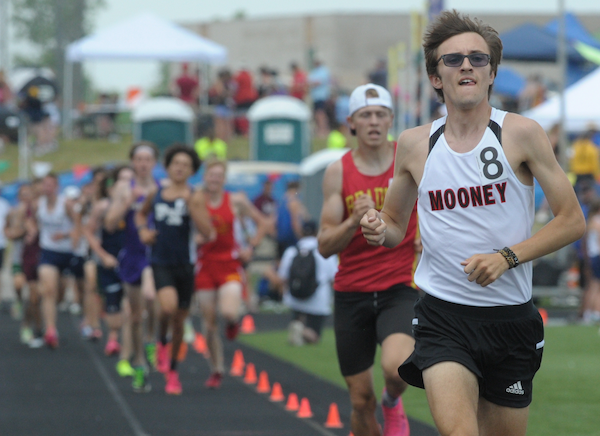 Coach Charissa Dean agreed.
Coach Charissa Dean agreed.
“The kids have big hearts,” she said after all the points were totaled and the Irish were on top once again, with 53. “They worked hard. They had a lot of potential when we started the season. And we had a lot of drive to put in the work, and we are happy the results came out the way they did.”
Reading was runner-up at 47 points, followed by Wyoming Potter’s House Christian with 42, then Fowler and Flint Beecher each with 37 points.
Senior Lezawe “Moses” Osterink, of Potter’s House Christian, placed second in 1,600 but took the 3,200 title as defending champ of both. He dominated the latter by lapping the field with a final lap kick that resembled more of a superhero speedster.
“Nobody really took it out that hard at the start,” he said. “There was a freshman (Marek Butkiewicz of Hackett) that tried to get the pace going quick, but me and Dakota (Dykhuis of Montabella) just kind of sat back and gradually pulled him through.
“We took it gradually, and I was just relying that I could kick.”
Kick did he ever. The trio were neck and neck the majority of the race in a grouping ahead of the pack.
“With 400 to go I just tried to go all out,” Osterink said. “I had a lot more left than I thought and I was pleased with the win. Not really the time, but that doesn’t matter, especially this hot out.”
The overall meet was in the low 90s/high 80s heat and searing sun all day. So, race officials allowed the unique opportunity for coaches to spray the runners with water and give them water bottles.
“It was very weird because I’ve never taken water to drink while I’m running, so I didn’t know how that would feel,” Osterink said. “And they were spraying us and hitting us in the face. It was kind of fun.”
Junior Tyler Lenn of Marine City Cardinal Mooney defeated Osterink at his own game in the 1,600.
“I’m feeling great,” Lenn said after grabbing the medal. “I said to a newspaper after one of my races (during the season) I was right where I wanted to be. This has been a long rebuilding process for me since an injury back in the fall, and I set a pretty high goal the day the injury happened. I was telling myself I needed to fulfill what I said I would do at the beginning of last cross country season. And that is what I did today.”
Lenn suffered an ankle sprain from a misstep that turned worse because he kept running through the season on it.
“Coming back from that was pretty tough, but I wouldn’t have it any other way,” he said. 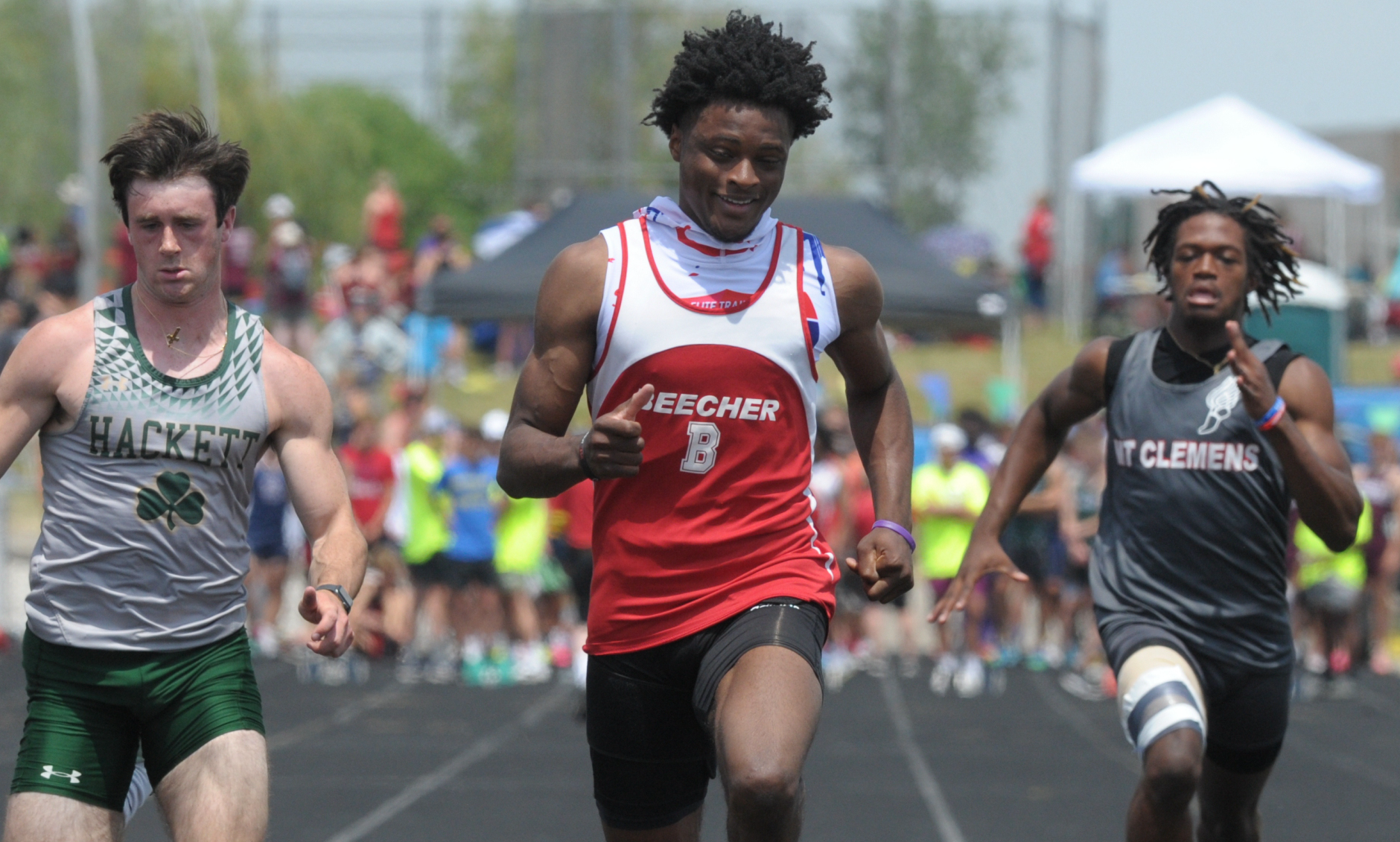 “Perseverance; I said from the beginning what I was going to do. I kept my eye on that target, and no matter the circumstances life threw at me, that I was going to make it happen and I am a man of my word.”
“Perseverance; I said from the beginning what I was going to do. I kept my eye on that target, and no matter the circumstances life threw at me, that I was going to make it happen and I am a man of my word.”
Jaylin Townsend, a senior from Flint Beecher, dominated the short races. He won the 100 dash (10.67) and 200 dash at 22 seconds flat. It was his third 100 win at a Finals.
“I put in a lot of work; I had to three-peat,” he said after the 100. “There’s a lot of great competition here, so I knew I had to come out and run my best.”
Concord in the 400 (43.72), Buckley in the 800 (1:30.76) and 1,600 (3:29.13) and Potter’s House in the 3,200 (8:14.18) were relay champs Saturday. Reading’s Tayshawn Bester won the 110 hurdles (15.13), and Athens’ Landen Bennett won the 300 (39.85). Caseville’s Nathan Feltner won the 400 (50.76), and Vestaburg’s Owen Patton claimed the 800 (1:55.11).
Fruitport Calvary Christian’s Bradley Richards won the high jump (6-10), and Peck’s Alex Affer won the long jump (23-4). McBain Northern Michigan Christian’s Isaac Bowden was first in pole vault (13-0), and Brown City’s Kyle Affer won shot put (49-2).
PHOTOS (Top) Kalamazoo Hackett Catholic Prep celebrates its third-straight LPD4 title Saturday. (Middle) Cardinal Mooney's Tyler Lenn, far right, sets the pace in the 1,600. (Below) Flint Beecher's Jaylin Townsend, middle, crosses the finish first for one of his two sprint championships. (Photos by Ken Swart/RunMichigan.com.)

